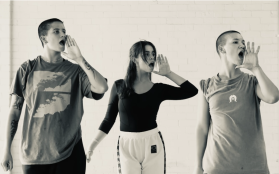First, a cold fact; then, a reality check; then some Points of Interest, perhaps missed in the immediate sweep of “winners”, “losers”, “pies” and “cakes” etc. Finally, a warning, a hot tip and a pain-point.
1. It is a truth universally acknowledged that democratic governments who produce National Cultural Policies (NCPs) sound decidedly naff. Sorry, but there’s no escaping it. If they aim for the high ground, they come across as pretentious. If they focus on deliverables, they seem venal. To condemn Revive because its tone makes your teeth ache is fruitless. Better to accept it as the government at their most awkward and sincere. After the Robodebt scandal, we can do with a bit of that, I’m sure. A policy that isn’t actively destroying the lives of its citizens is a step in the right direction for the Australian nation as a whole.
2. NCPs make their presence felt over time. Some by-eye assessment can be done in the days following their announcement. But everything important in Revive will slow-release over months, even years, and in unexpected ways. The devil isn’t in the detail. It’s in the big picture that gels the details into meaningful sectoral impacts. Which sections are pivotal and which soundbites remains to be seen. That’s OK too. What’s important is that the government make a start so the cultural sector can envisage a version of the future better than its benighted past.
In short, it is premature to either overly praise or criticise Revive, while talk of its weaknesses and strengths as if these were self-evident should be treated with caution. That is especially true of the money side. The last Coalition government was adept at proclaiming funding they did not deliver or failing to pass enabling legislation. Let’s hope Labor is more transparent. At least Revive gives them a cultural policy to be more transparent about.
3. Points of Interest. Stuart Cunningham calls policy-making ‘ideas thick‘. NCPs are built on the bones of past policies, not just the ones they acknowledge (Creative Nation, Creative Australia), but satellite documents that once had influence. Revive’s Five Pillars recalls Jon Hawkes’ book The Fourth Pillar of Sustainability: Culture’s Essential Role in Public Planning (2001). In turn, this draws on David Yencken and Debra Wilkinson’s Resetting the Compass: Australia’s Journey Towards Sustainability (2000), which discusses ‘sustainable policy in the full meaning of that word… ecological, social and cultural as much as economic’.
That’s an important ancestry, and a reminder that policy-making is an intergenerational endeavour. Revive benefits from the metaphors in which it clothes its actions. But it is also held to account by them. More on this later, when examining the pain point: the word “sustainable” in the NCP.
For those regularly engaged with cultural policy documents, it is a relief not to hear that selling NFT kangaroos on the digital art market is going to send the country’s GDP into the stratosphere. The “economy” and its cognate terms appear a modest 36 times in Revive. By contrast, the terms “arts”, “culture” and their cognates appear over 1000 times.
That doesn’t mark a switch to a non-instrumental, art-for-arts-sake policy perspective, however. It marks yet another chapter in the complex entanglement between the economism that has dominated government thinking for 40 years and the aspiration to ‘ensure Australians see themselves, better understand each other, and help the world to know us’.
To better appreciate these subcutaneous tensions think of Revive as having two voices. The first speaks the language of culture-as–culture: of place, respect, creativity and truth. This is most evident in Pillar 1: First Nations First. The second speaks the language of culture-as-commerce: of entrepreneurialism, business skills, technology and investment. This is washed through the document like a background colour. There is a palpable concern with markets and market share, especially export markets.
Not unreasonably, given that overseas corporations dominate so much of Australia’s cultural consumption. Yet by insisting on a commercial focus to a remixed Australia Council, Revive fudges important market failure and public good arguments for assistance to the arts, while making an implied claim that managing for-profit production is a natural thing for a statutory body to do.
It’s an upbeat view of the commercial ethos, a better fit for some artforms (like contemporary popular music) than for others. Meanwhile, the broader economic picture, as Revive itself admits, is dreadful. Flat incomes, deteriorating working conditions, wage theft, rapacious increases in “capital share” at the expense of “labour share”: this bitter reality is not confined to the cultural sector. Attempts to improve the lives of Australian artists using “values-based capitalism” won’t succeed without improving the lot of Australian workers as a whole.
It’s not clear to me how tub-thumping the virtues of commercial producers helps this issue. Wanting to make money from culture is different from wanting to make culture. The marriage can work. But the fact that historically it didn’t is the chief reason governments started supporting culture in the first place.
4. My warning to the Minister: don’t push the language of well-being-togetheryness too hard. Culture is where people achieve Orphic union, yes. It is also where they seriously piss each other off. Framing culture as if it were another health service usually ends up with apoplectic politicians and viral social media feeds. Creating the conditions in which people can create requires an open heart and a thick skin. Ministers must practise understanding for the sector as a whole, not just the artforms they happen to know and like.
5. My hot tip: the NCP proposes ‘improved data collection’ to ‘demonstrate the value of the cultural and creative sector’. Compared to Creative Australia, the evaluation section is refreshingly short. I won’t backchat the goal of ‘establishing clear benchmarks to measure success’, only say that re: culture it is like trying to lasso gravy. But I would add an indicator: the Meyrick Metric. This counts the hours that artists and organisations spend applying for, or reporting on, cultural grants. It calculates it as both an absolute measure and a percentage of money received, weighting it against the resources available to write these applications and reports. That data will be illuminating. I guarantee it.
6. The pain point. The further into Revive one reads, the more culture-as-commerce replaces culture-as-culture. Pillars 4 and 5, Strong Cultural Infrastructure, and Engaging the Audience, have a technocratic, market logic feel. A plum section is “Private Sector Support” discussing the absorption of Creative Partnerships Australia into Creative Australia. It notes:
‘There is an opportunity to foster increased partnerships between commercial and non-for-profit arts sector organisations, and to drive co-investment for the creation of original Australian stories and artistic works… There is also a role for increased mentoring and support to develop business skills and entrepreneurship across the sector, and to develop sustainable business models.’
Here’s the nipple-pinch. The term “sustainable” and its cognates appears 23 times in Revive, but mostly in a way that would make Yencken and Wilkinson wince; that is as financial sustainability, reducing the word’s ecological, social and cultural resonances and the “pillars” metaphor the authors use to explore them.
If private philanthropy and corporate sponsorship are to be brought more fully into the funding mix it must clearly be done on a different moral basis (or, in the case of fossil fuel companies, not done at all). In private-public partnerships, the phrase “giving back” should appear more often than “return on investment”, while the attitude of private firms needs more of the concerned citizen, less of the noblesse oblige.
That’s a big ask from a corporate sector that often talks as if the business of the Australian government should be business, not Australia. A case may be made for artists mentoring corporate executives, to develop their empathy and imagination skills. That would be a different take on “sustainability”, one arguably more in tune with our times.
But if the back end of Revive is a different beast from the front end, and its ethical desires sit uneasily with its financial strategies, that reflects Australia right now. We are in the unenviable position of facing a terrifying future while trying to come to terms with a violent colonial past. If we are divided about how to deal with our cultural present, is that so surprising?
Coming up with an NCP at such a juncture is a big achievement, and should be acknowledged as such. There are no glittering awards for cultural policy-makers, no interesting metallic objects or coloured rosettes. It is an unlovely, thankless task, not made easier by the fact that democratic societies now insist that if NCPs aren’t for everyone, they aren’t for anyone at all.
Revive isn’t perfect, and there are troubling undertones to parts of it. But compared to the Big Nothing that Australian cultural policy was, it is a Solid Something from which we can proceed.





